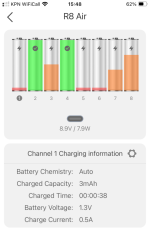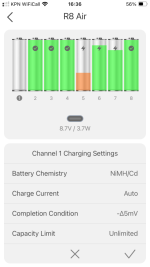Voltage. 1.2V NiMHs often "die" while there is plenty of charge remaining. With 3.2V and a very flat discharge curve you can power electronics far longer than 2-3x AA.
This is not correct.
Joules are joules. A 2500mAh NiMH AA has about the same capacity as a 950mAh LiFePO
4 14500, and is the same size. Actual battery life depends on how the device is designed:
- If a device is designed for alkalines, the NiMH will not last long due to the voltage not being high enough for much of the discharge curve (starting at 1.2V and drooping a bit, as opposed to starting at 1.5V and drooping more but spending a lot of time above 1.2V), and the LiFePO4 will set it on fire.
- If a device is designed for alkalines and NiMHs (e.g. it uses an internal boost converter to deal with a wider range of input voltages), which lasts longer depends on the current demand:
- Very low current, alkalines will last significantly longer because their self discharge is significantly lower than even low self discharge NiMH.
- Low current, alkalines will last a moderate amount longer because their capacity is higher.
- High current, NiMH will last longer because they lose significantly less capacity as loads increase.
- LiFePO4 will still set it on fire.
- If a device is designed for a wide range of input voltages, like 1.2-3.8V (i.e. NiMH to Li-NMC) using a more advanced internal power supply circuit, then what lasts the longest depends on load (NiMH and Li-Ion can both handle high power draws, alkaline still can't, but alkalines still have the highest capacity at very low loads) and whatever has the highest capacity in WH. There is also some efficiency gain if your input voltage is the same as or above the voltage required by your load, so for example the power supply in a LED flashlight driving a 3V LED will waste less energy in conversion when driven by a Li-ion than by a NiMH.
As far as why 14500 lithium chemistry family batteries exist, they're primarily for when you want to pull a
lot of energy out of very small cells very quickly. Think tiny, high power flashlights and vapes. Both NiMH and Li-NMC can handle 2-3A loads, but 2A from NiMH is 2.4W, while 2A from Li-NMC is 7.4W, about three times as much power (remember the difference between power and energy here). More exotic variants of Li-NMC can handle even more current, and a properly made LiFePO
4 is going to be more limited by getting the heat from internal resistance out than it is by the current delivery ability of the chemistry.
@iljitsch, you're correct that it's doubtful the higher power delivery from such a small battey (and thus device) is actually useful, though. A flashlight that can pull 7W out of a Li-ion 14500 is going to get too hot to hold in minutes to seconds, and either drastically reduce power draw (and thus light output) due to thermal throttling (very common), or just set itself on fire. A vape actually wants the heat given what it does, but vapes are inherently stupid to begin with.
NiMh will report low voltage because the discharge curve has a shallow curve compared to Lithium.
Where Lithium there is almost no way of making a low power indicator as the cut off is drastic.
Uh, what? Both chemistries fall off a cliff voltage-wise at the end of their discharge. For most of their capacity, NiMH actually has a flatter curve than Li-ion.



